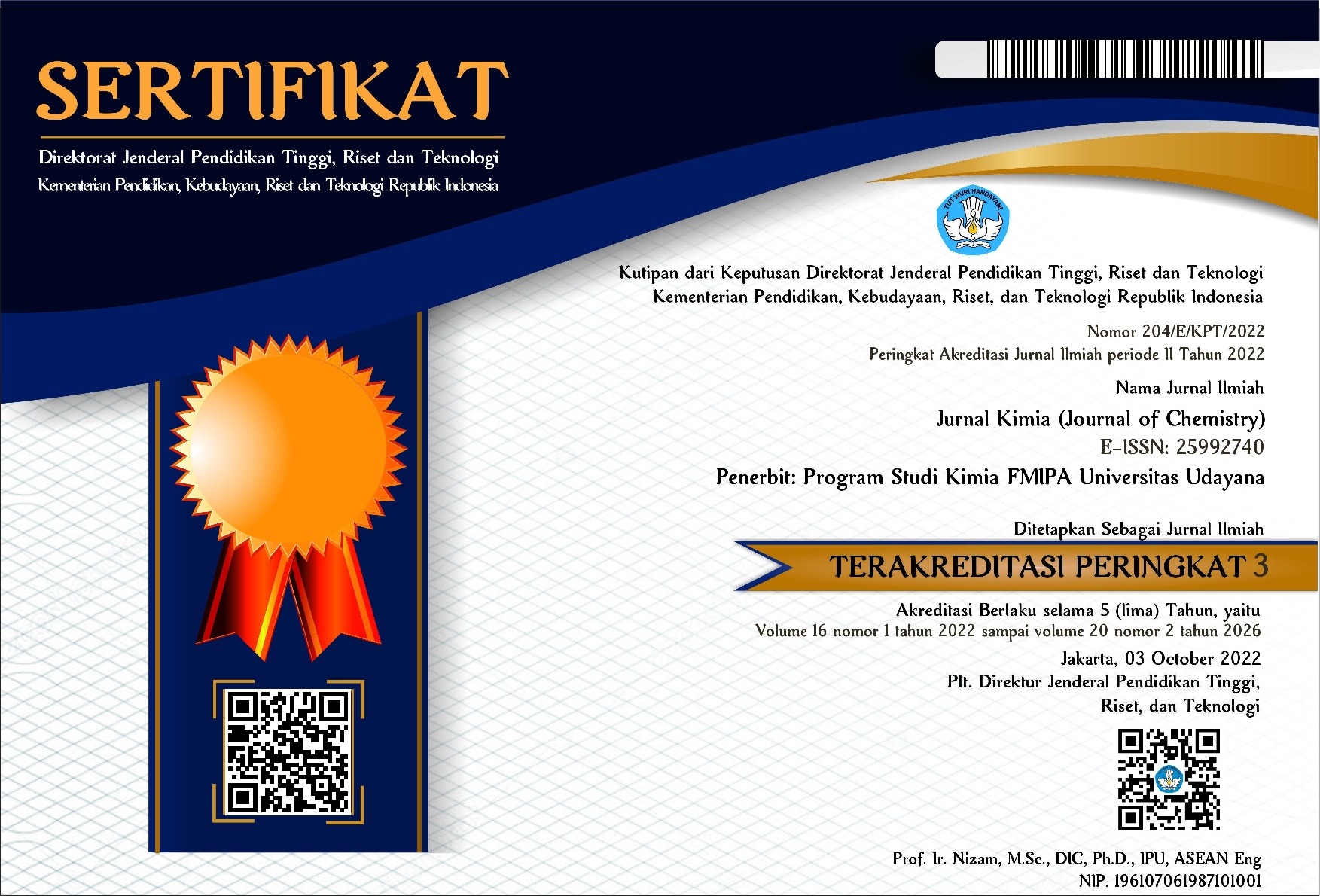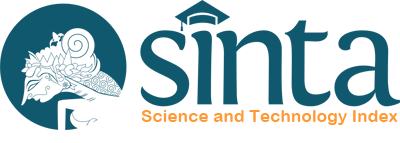SYNTHESIS OF ZNCL2-ACTIVATED COCONUT SHELL ADSORBENT FOR MERCURY REMOVAL
Abstract
Kontaminasi merkuri dalam air menimbulkan risiko besar bagi organisme dan ekosistem. Pengurangan merkuri dari air yang terkontaminasi sangat penting untuk meningkatkan kualitas air. Metode adsorpsi, khususnya menggunakan adsorben yang berasal dari limbah biomassa, telah menunjukkan hasil yang menjanjikan dalam proses penjernihan air. Adsorpsi logam merkuri menggunakan arang aktif dari tempurung kelapa telah diteliti dengan menggunakan metode eksperimental. Penelitian ini bertujuan untuk menghilangkan kadar logam merkuri dalam air dengan menggunakan variasi suhu kalsinasi. Tempurung kelapa dibakar menggunakan furnace pada suhu 300 °C dan 450 °C. Bubuk arang tersebut kemudian diaktivasi secara kimia menggunakan ZnCl2 selama 24 jam. Material dikarakterisasi menggunakan XRD dan FTIR untuk mengetahui fasa kristal dan gugus fungsi yang terkandung dalam material. Material diuji dalam simulasi larutan merkuri, dan konsentrasi merkuri yang tersisa diukur menggunakan AAS. Berdasarkan hasil karakterisasi XRD, mineral grafit ditemukan pada material yang dikalsinasi pada suhu 300 °C dan 450 °C. Sementara itu, beberapa gugus fungsi mempunyai muatan positif dan negatif pada permukaan material. Hasil penelitian menunjukkan bahwa material hasil kalsinasi suhu 300 °C menghasilkan %R dan Qe tertinggi, yaitu masing-masing sebesar 99,91 mg/L dan 9,991 mg/g, secara berurutan. Penelitian ini membuktikan bahwa limbah tempurung kelapa mampu menurunkan kadar logam merkuri dalam air. Tempurung kelapa dapat dimanfaatkan sebagai adsorben pada proses pengolahan limbah hasil proses industri.
Kata kunci:
Adsorpsi, Arang aktif, Tempurung kelapa, Merkuri
ABSTRACT
Mercury contamination in water poses severe risks to both living organisms and ecosystems. Removing mercury from contaminated water is crucial for enhancing water quality. The adsorption method, particularly using adsorbents derived from biomass waste, has shown promising results in this purification process. The adsorption of mercury metal using activated charcoal from coconut shells has been investigated using experimental methods. This research aimed to remove mercury metal levels in water by varying the calcination temperature. Coconut shells were calcinated using a furnace at 300°C and 450°C. Afterward, the charcoal powder was chemically activated using ZnCl2 for 24 hours. The material was characterized using XRD and FTIR to determine the crystal phase and functional groups contained in the material. The material was tested in a simulated mercury solution, and the remaining mercury concentration was measured using AAS. Based on the XRD characterization results, graphite minerals were found in the material calcined at 300°C and 450°C. Moreover, several functional groups had positive and negative charges on the material's surface. The finding showed that the material from calcination at 300°C yielded the highest %R and Qe, namely 99.91 mg/L and 9.991 mg/g, respectively. This research proved that coconut shell waste can reduce mercury metal levels in water. The coconut shell is able to act as an adsorbent in the waste processing process resulting from industrial processes.
Keywords:
Adsorption, Activated charcoal, Coconut shell, mercury
Downloads
References
Alomar, T., Qiblawey, H., Almomani, F., Al-Raoush, R. I., Han, D. S., & Ahmad, N. M. 2023. Recent Advances on Humic Acid Removal from Wastewater Using Adsorption Process. Journal of Water Process Engineering. 53: 103679.
Al-Sareji, O. J., Meiczinger, M., Somogyi, V., Al-Juboori, R. A., Grmasha, R. A., Stenger-Kovács, C., Jakab, M., & Hashim, K. S. 2023. Removal of Emerging Pollutants from Water Using Enzyme-Immobilized Activated Carbon from Coconut Shell. Journal of Environmental Chemical Engineering. 11(3): 109803.
Arthur, L., Vondolia, G. K., & Dasmani, I. 2023. Traditional Beliefs and Willingness to Pay for Improving a Mining-Polluted River in Ghana. Heliyon. 9(12).
Baharum, N. A., Nasir, H. M., Ishak, M. Y., Isa, N. M., Hassan, M. A., & Aris, A. Z. 2020. Highly Efficient Removal of Diazinon Pesticide from Aqueous Solutions by Using Coconut Shell-Modified Biochar. Arabian Journal of Chemistry. 13(7): 6106–6121.
Bakti, A. I., Lumembang, M. M., & Jumriadi. 2023. Karakterisasi Karbon Aktif yang Terbuat dari Tempurung Kelapa Menggunakan Teknik Pirolisis dengan Aktivasi Fisika dan Kimia. Jurnal MIPA. 12(2): 56–60.
Chen, A., Danfakha, F., Hausermann, H., & Gerson, J. R. 2023. Education and Equipment Distribution Lead to Increased Mercury Knowledge and Retort Use in Artisanal and Small-Scale Gold Mining Communities in Senegal. Cleaner Production Letters. 5: 100050.
Crespo-Lopez, M. E., Augusto-Oliveira, M., Lopes-Araújo, A., Santos-Sacramento, L., Yuki Takeda, P., Macchi, B. De M., Do Nascimento, J. L. M., Maia, C. S. F., Lima, R. R., & Arrifano, G. P. 2021. Mercury: What Can We Learn from The Amazon? Environment International. 146: 106223.
Franzaring, J., Haneke, J., Sannino, A., Radermacher, G., & Schweiger, A. 2024. Effects of Legacy Mining on Mercury Concentrations in Conifer Needles and Mushrooms in Northern Palatinate, Germany. Environmental Pollution. 357: 124406.
He, C. L., & Zong, W. J. 2019. Diffraction Effect and Its Elimination Method for Diamond-Turned Optics. Optics Express. 27(2): 1326-1344.
Honorisal, M. B. P., Huda, N., Partuti, T., & Sholehah, A. 2020. Sintesis dan Karakterisasi Grafena Oksida dari Tempurung Kelapa dengan Metode Sonikasi dan Hidrotermal. Teknika: Jurnal Sains dan Teknologi. 16(1): 1-11.
Hu, S. Yu, Hui, C. Ye, Wu, C., Gao, C. Xian, Huang, Z., & Guo, Y. 2024. Dual-Colored Bacterial Biosensor Responsive to Cadmium, Mercury, and Lead for Detecting Heavy Metal Pollution in Seawater. Ecological Indicators. 166: 112244.
Indrawan, G. S., Arthana, I. W., & Yusup, D. S. 2018. The Content of Lead Heavy Metal (Pb) in Shellfish at Serangan Coastal Area Bali. Metamorfosa: Journal of Biological Sciences. 5(2): 144.
Indrawan, G. S., & Putra, I. N. G. 2021. Heavy Metal Concentration (Pb, Cu, Cd, Zn) In Water And Sediments In Serangan Waters, Bali. Metamorfosa: Journal of Biological Sciences. 8(1): 115.
Isa, S. A., Hafeez, M. A., Singh, B. K., Kwon, S. Y., Choung, S., & Um, W. 2022. Efficient Mercury Sequestration from Wastewaters Using Palm Kernel and Coconut Shell Derived Biochars. Environmental Advances. 8: 100196.
Kosela Soleh. 2010. Cara Mudah dan Sederhana Penentuan Struktur Molekul Berdasarkan Spektra Data (NMR, MASS, IR, UV). Jakarta: Lembaga Penerbit Fakultas Ekonomi Universitas Indonesia.
Kulkarni, S. J., Tapre, R. W., Patil, S. V., & Sawarkar, M. B. 2013. Adsorption of Phenol from Wastewater in Fluidized Bed Using Coconut Shell Activated Carbon. Procedia Engineering. 51: 300–307.
Lago, A., Silva, B., & Tavares, T. 2024. Biowaste Valorization on Pharmaceuticals and Pesticides Abatement in Aqueous Environments. Sustainable Materials and Technologies. 39: e00792.
Leslie Mendame, L., Silangen, P., & Rampengan, A. 2021. Perbandingan Karakteristik Karbon Aktif Arang Tempurung Kelapa dan Arang Tempurung Kemiri Menggunakan Scanning Electron Microscopic dan Fourier Transform InfraRed. Jurnal Fista: Fisika dan Terapannya. 2(2): 105–108.
Lladó, J., López, F., Rossell, J. M., Lao-Luque, C., Gil, R. R., Fuente, E., & Ruiz, B. 2024. Multivariate Analysis of Pharmaceutical Pollutants Adsorption in Aqueous Media with Tailored Waste-Based Carbonaceous Adsorbent Materials and Commercial Activated Carbons. Sustainable Chemistry and Pharmacy. 38: 101453.
Mariwy, A., Septory, A. N., & Untailawan, R. 2023. Analisis Kandungan Logam Berat Merkuri (Hg) pada Sedimen di Perairan Desa Batuboy Teluk Kayeli Pulau Buru. Molluca Journal of Chemistry Education (Mjoce). 13(1): 23–31.
Mastiani, N., Amalia, V., & Rosahdi, T. D. 2018. Potensi Penggunaan Tempurung Kelapa sebagai Adsorben Ion Logam Fe(III). Al-Kimiya. 5(1): 42–47.
Mohamad Yusop, M. F., Mohd Johan Jaya, E., & Ahmad, M. A. 2022. Single-Stage Microwave Assisted Coconut Shell Based Activated Carbon for Removal of Zn(II) Ions from Aqueous Solution–Optimization and Batch Studies. Arabian Journal of Chemistry. 15(8): 104011.
Mohan, I., Jasrotia, R., Dhar, S., Bhau, B. S., Pathania, D., Khargotra, R., & Singh, T. 2024. Pollution Indices and Correlation of Heavy Metals Contamination in The Groundwater Around Brick Kilns in Jammu and Kashmir, India. Heliyon. 10(6): e27869.
Piedad Martín-Olmedo, Joseph V. Spadaro, Andrea Ranzi, F. R. 2023. Health Impact Assessment of Steel Plant Activities in Taronto, Italy.
Prasoetsoph, N., Soonsook, I., Panyayaw, A., Nanon, P., Singsang, W., & Sittitanadol, I. 2023. Adsorption of Methylene Blue and Ferrous Metal Solution by Using Coconut Shell Charcoal. Journal of Materials Science and Applied Energy. 12(2): 248672.
Putri, N. A., & Supardi, Z. A. I. 2023. Sintesis Dan Karakterisasi Graphene Oxide (GO) dari Bahan Alam Tempurung Kelapa. Inovasi Fisika Indonesia. 12(2): 47–55.
Rahman, M., Chaity, I. J., Hossain, Md. I. S., & Siddique, M. A. M. 2024. Surface Water Pollution by Some Heavy Metals in A Remote Island, Hatiya, Northern Bay of Bengal. Journal of Trace Elements and Minerals. 8: 100150.
Rizwan, M., Murtaza, G., Zulfiqar, F., Moosa, A., Iqbal, R., Ahmed, Z., Khan, I., Siddique, K. H. M., Leng, L., & Li, H. 2024. Tuning Active Sites on Biochars for Remediation of Mercury-Contaminated Soil: A Comprehensive Review. Ecotoxicology and Environmental Safety. 270: 115916.
Sitarska, M., Traczewska, T., Filarowska, W., Hołtra, A., Zamorska-Wojdyła, D., & Hanus-Lorenz, B. 2023. Phytoremediation of Mercury from Water by Monocultures and Mixed Cultures Pleustophytes. Journal of Water Process Engineering. 52: 103529.
Sujiono, E. H., Zabrian, D., Zurnansyah, Mulyati, Zharvan, V., Samnur, & Humairah, N. A. 2022. Fabrication and Characterization of Coconut Shell Activated Carbon Using Variation Chemical Activation for Wastewater Treatment Application. Results in Chemistry. 4: 100291.
Tamjidi, S., & Esmaeili, H. 2019. Chemically Modified CaO/Fe3O4 Nanocomposite by Sodium Dodecyl Sulfate for Cr(III) Removal from Water. Chemical Engineering and Technology. 42(3): 607–616.
Ugwu, D. I., & Conradie, J. 2024. The Use of Bidentate Ligands for Heavy Metal Removal from Contaminated Water. Environmental Advances. 15: 100460.

This work is licensed under a Creative Commons Attribution 4.0 International License





